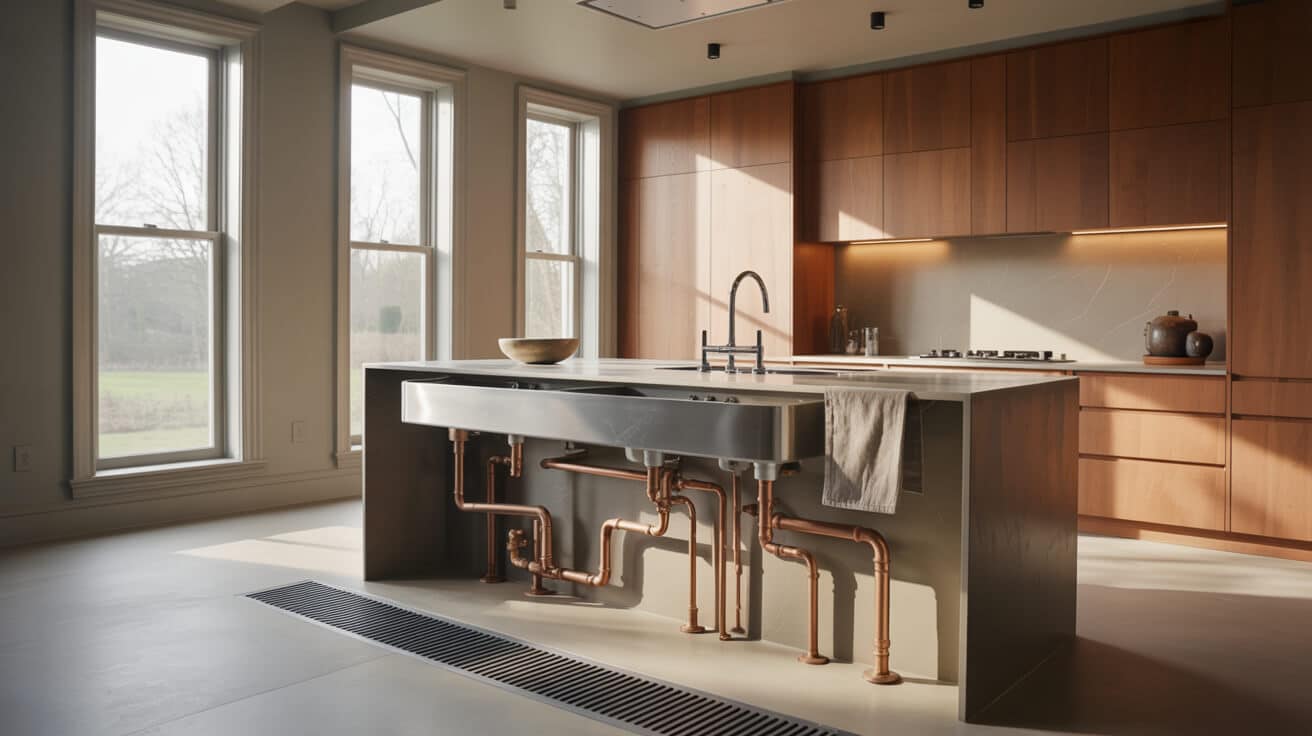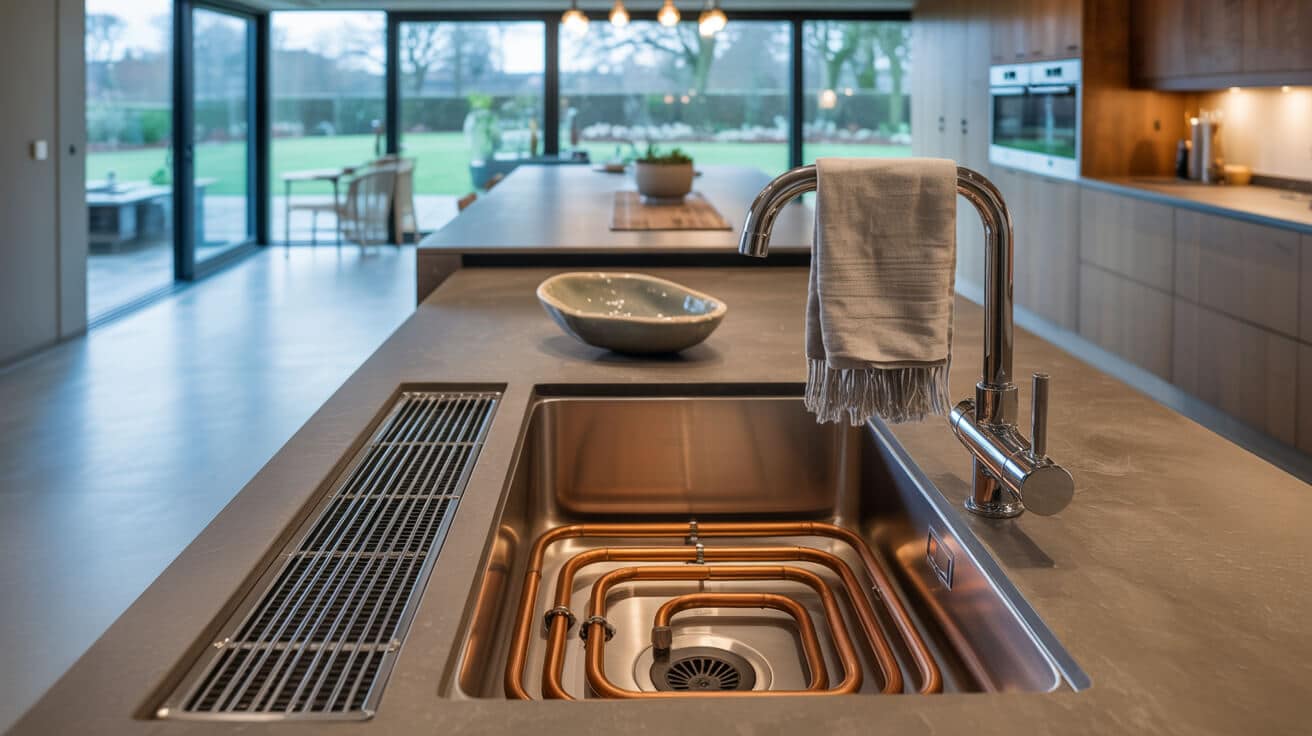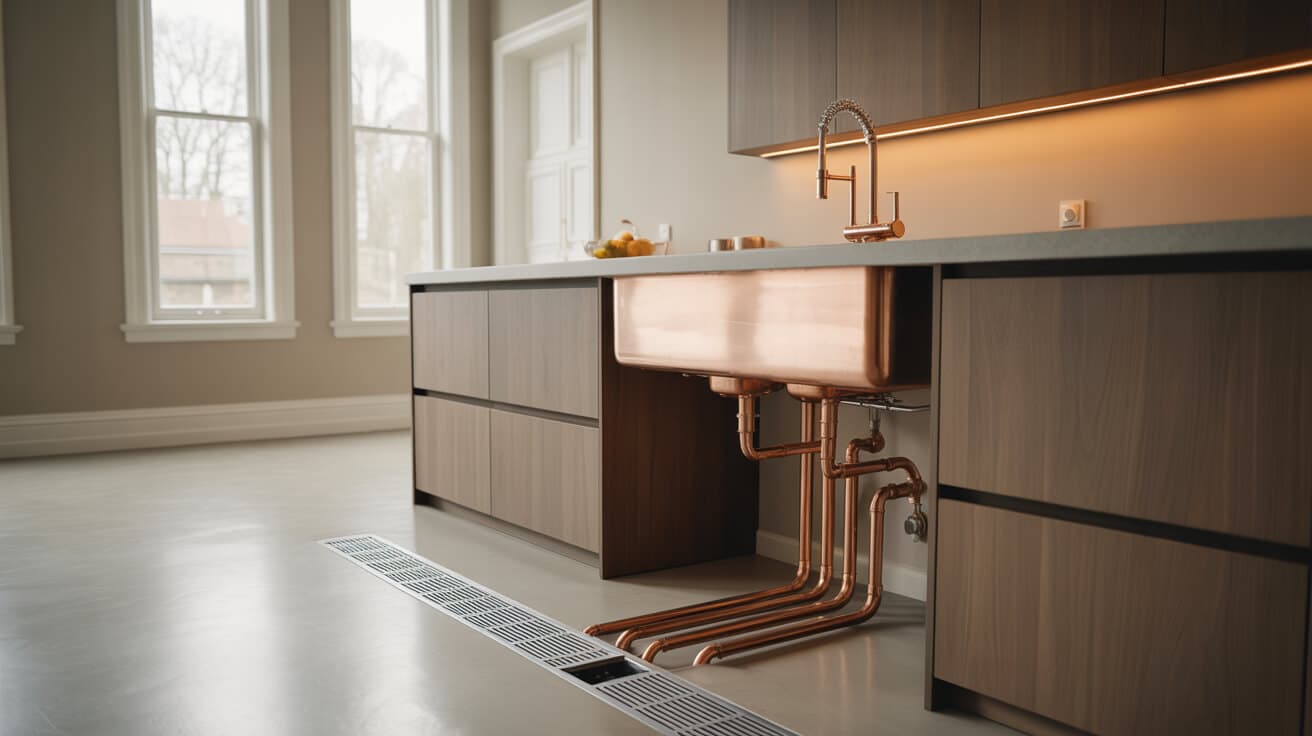Detached house plumbing represents a foundational infrastructure domain, shaping habitability, health, energy efficiency, and property value. Its independence affords opportunities for pressure optimization, system zoning, personalised control, and efficient integration with site-specific features such as outbuildings or landscape irrigation. The requirement for compliance with rigorous building codes, safety regulations, and water quality standards situates detached house plumbing at the intersection of residential engineering, regulatory scrutiny, and user-centred design. Expert interventions—such as those offered by Plumbers 4U—are routinely sought for installation, upgrades, diagnostics, and maintenance, ensuring your property benefits from current best practices and regulatory assurance.
Etymology or Name Origin
The word “plumbing” traces to the Latin “plumbum,” signifying lead, reflecting the historical prevalence of lead pipes in early water distribution networks. Over time, “plumbing” has expanded to encompass all technical systems for water conveyance, heating, and sanitation within built environments. The term “detached house” is standardised in construction, real estate, and building regulation as a dwelling that stands completely apart from other structures, having no attached or adjoining walls. In technical manuals and regulatory texts, “detached” conveys the infrastructural and legal independence of the site, informing bespoke plumbing approaches that differ fundamentally from those adopted in connected or multi-family dwellings.
Overview / Context
Detached houses are residences situated on their own plots, without structural connection to neighbouring buildings, often allowing for greater architectural flexibility. Plumbing in these dwellings is engineered as an autonomous infrastructure, with dedicated water mains entry, individualised pressure management, separate drainage paths, and full control over internal and external fixture placement.
Major differentiators from semi-detached or terraced homes include:
- Full separation of water entry and waste exit points, reducing cross-property influences.
- Opportunity to design long supply and drainage runs to accommodate larger footprints and garden or auxiliary structures.
- Possibility for advanced zoning—dividing your property into independent circuits for bathrooms, kitchens, utility spaces, and outbuildings.
- Fewer systemic constraints imposed by shared party walls or service risers.
Plumbers 4U and similar companies structure services around site assessment, compliance mapping, tailored system design, and lifecycle support, ensuring your property’s infrastructure aligns with evolving codes, lifestyle needs, and efficiency targets.
Key definitions
- Detached House: A stand-alone dwelling with no shared walls or roofs, offering complete infrastructural control.
- Plumbing System: The interconnected network of pipes, appliances, valves, and waste channels managing potable water, heating, and sanitation.
Company and trade context
Professional plumbing firms are your partners in safeguarding property value and safety via compliant design, installation, maintenance, and upgrades. The convergence of modernization, energy benchmarking, and regulatory demands has led to multifaceted service offerings—including energy performance consultation, emergency callouts, compliance certification, and integration of smart, water-saving, or environmentally adaptive infrastructure.
Comparative elements
In contrast to attached dwellings:
- Supply and waste lines can be routed more flexibly, supporting bespoke zone layouts.
- Larger properties may require boosted pressure zones or distributed hot water cylinders.
- Drainage and stormwater can be engineered for the unique landscape, enhancing flood resistance and sustainability.
History
Origins
Early plumbing in stand-alone homes often relied on hand-dug wells, earthenware or timber conduits, and basic cesspits, providing rudimentary water and sanitation. Lead, due to its malleability and water resistance, featured widely in pipework until public health concerns motivated a transition to copper, clay, and iron pipes.
Industrial emergence
With urbanisation and legislative interventions (e.g., 19th- and 20th-century plumbing codes), material science progressed to steel, galvanised iron, and, eventually, plastics. Smoother internal surfaces enabled higher flow rates and lower scaling; mass production brought affordable fixtures and cold- and hot-water supply to most homes. Regulation began to codify pressure, venting, waste, and backflow standards, giving rise to the modern professional plumbing trade.
Contemporary evolution
Today’s detached house plumbing integrates pressurised supply systems, thermostatically protected heating, sophisticated waste management, and compatibility with renewable technologies. Building regulations now address water and energy efficiency, Legionella prevention, backflow safety, and accountable work documentation. Companies like Plumbers 4U actively lead in digital record-keeping, use of benchmark logbooks, and the adoption of modular, upgradable system components.

Concept / Description
Plumbing in detached houses centres on a modularized, multi-zone network of pressurised and gravity-fed pipes, valves, pumps, and devices delivering potable water, heat, and waste management. The system encompasses:
- Water Entry: Direct mains or private supply (occasionally well or borehole); isolation at a dedicated stopcock; metering; pressure regulation.
- Distribution: Branch or manifold layouts; copper, PEX, or MDPE pipes; strategic zoning for pressure management and maintenance; use of backflow prevention and flow restrictors.
- Hot Water Production: System or combi boiler, cylinder, or point-of-use heaters; inclusion of expansion vessel, tundish for unvented cylinders (G3 compliance), TMV for anti-scalding.
- Heating: Wet radiator circuits, underfloor heating loops, programmable zone controls, room stat or TRV integration.
- Fixtures: Bathroom, kitchen, utility, and outbuilding endpoints; integration of isolation valves, appliance tees, and accessible trap assemblies.
- Waste: Soil stack with SVP, anti-syphon traps, branch waste crossings; subsurface drainage; interface to public sewer or septic system.
Detachment of the property permits nuanced customization, enabling your plumber to optimise every component for your specific lifestyle, spatial constraints, and environmental setting.
Core system components
| Component | Typical Function |
|---|---|
| water metre / Stopcock | Controls entry and facilitates service isolation |
| Pressure Reducing Valve (PRV) | Balances mains pressure to suit system design |
| Unvented Hot Water Cylinder | Delivers pressurised hot water; requires G3 certification |
| TRV / TMV | Enables zone control/adaptive temperature mixes |
| Expansion Vessel / Tundish | Protects system integrity; required for certain cylinders |
| Soil Stack (SVP) | Ventilates and drains waste vertically |
| Magnetic Heating Philtre | Captures debris for system protection |
| Outdoor Taps | Connect with non-return valve to prevent cross-contamination |
Functionality / Purpose / Applications
Detached-house plumbing systems supply potable water, provide climate control, and remove waste—empowering your household with the autonomy and reliability demanded by diverse living arrangements. Key applications include:
- Multi-bathroom, high-demand configurations: Simultaneously serve several outlets with balanced pressures and temperature stability.
- Home offices and remote areas: Isolate or boost pressure to workspaces, garden buildings, or remote utility rooms.
- Sustainability and cost-reduction upgrades: Integrate rainwater harvesting, solar thermal preheat, or water-saving devices for long-term efficiency.
Impact on quality of life and asset protection
Effective plumbing delivers hygienic sanitation, comfort across all seasons, and protects your home from costly leaks, water hammer, or system failures. Owners enjoy peace of mind, knowing systems are configured to mitigate freezing, overheating, or contamination—even under unusual or challenging conditions.
Pain points and problem/solution dynamic
- Hidden Leaks & Pipe Noise: Through regular professional assessment, detection technology (acoustic or thermal), and best-practice routing, you minimise disruptions and property risk.
- Pressure Drop Concerns: Zoning and manifold layouts tailored to your property’s unique demand profiles enhance consistency.
- Regulatory Anxiety: Certified installation, scheduled maintenance, and digital reporting streamline compliance with evolving codes.
Classifications / Types / Variants
System architectures for detached houses are guided primarily by the pressure regime, material selection, and the need for future adaptability.
Principal system types
- Gravity-Fed: Utilises a cold-water storage tank, typically in the loft, with head pressure driving supply; increasingly rare except in older or rural properties.
- Pressurised/Direct Mains: Accesses municipal or private main directly; supports modern, sealed-circuit heating and allows multiple high-demand fixtures.
- Combi-Boiler Only: Provides instant hot water and heating, with minimal storage, fitting compact footprints or smaller detached homes.
- Hybrid/Modular: Integrates legacy gravity sections with a pressurised extension (e.g., for an extension or converted outbuilding).
- Renewable-Ready: Engineered with solar coil cylinders, rain or greywater feeds, thermal integration, and dedicated controls for low-carbon living.
Material and layout typology
- Pipe materials: From copper and PB for conventional builds, to PEX or multilayer for flexible routing and reduced installation time.
- Fixture zoning: Suites or outbuildings often serviced via independent circuits with isolation at the manifold or branch.
- Ancillary appliances: Water softeners, acid neutralizers, and UV sterilisation increasingly found in regions with aggressive water chemistry or high regulatory standards.
Systems / Tools / Methodologies
Successful detached house plumbing execution depends on robust methodologies and expert instrumentation.
Systems and methodologies
- Branch vs. Manifold Distribution: Manifold layouts facilitate individual fixture control and rapid isolation for maintenance, while branch (trunk and spur) systems can shorten instal time in smaller homes.
- Commissioning Protocols: Include pressure tests, flow verification, temperature stabilisation, and water quality sampling at handover. Digital photos or diagrams may support your asset documentation.
- Ongoing Maintenance Planning: Annual flush and inhibitor checks for heating circuits, renewal of sacrificial anodes in cylinders, verification of all safety valves.
Essential tools
- Hand Tools: Pipe cutters (all materials), torque wrenches, deburrers, integrity testers.
- Diagnostics: Pressure and flow metres, thermal imaging for hidden leaks, carbon monoxide/damp detectors.
- Commissioning Equipment: Flush kits, inhibitor dosing, water hardness/quality kits.
- Documentation Aids: Digital logbooks, visual system mapping, and component labelling streamline ongoing maintenance and insurance compliance.

Stakeholders / Entities Involved
Efficient and resilient plumbing for detached houses emerges from collaboration among several stakeholder types:
Primary entities
- You, the Homeowner: Make strategic choices regarding system design, upgrades, and scheduled maintenance, balancing lifestyle needs with regulatory and financial goals.
- Plumbers 4U (or equivalent company): Executes survey, design, installation, code certification, and long-term service, bringing technical, regulatory, and customer-service expertise to your project.
- Installers/Engineers: Trained and accredited specialists responsible for the integrity, code compliance, and longevity of your system.
- Regulators and Inspectors: Oversee conformity to statutory codes and standards, often requiring site inspections or documentary evidence before sign-off.
Secondary stakeholders
- Landlords/Agents: Share in compliance responsibilities when owning or managing multiple properties, particularly regarding notifiable work, annual safety checks, and tenant communication.
- Insurers: Need assurance that your plumbing system is fully code-compliant and inspected before full coverage applies.
- Residents/Tenants: Impact system demand, identify faults during use, and may request selective upgrades or adaptations.
Legal / Regulatory / Ethical Considerations
Plumbing in detached houses is governed by multi-tiered legislative and ethical frameworks designed to protect safety, water quality, occupant health, and the environment.
Regulatory codes and standards
- Building Regulations (England & Wales): Parts G (Sanitation, hot water safety), H (Drainage), L (Conservation of fuel and power), and P (Electrical safety in dwellings).
- Water Supply Regulations: Mandate the use of WRAS-approved fittings, installation notification to your water company, and prescribed backflow prevention.
- G3 Regulation: Applies to unvented hot water cylinders, requiring certified installers and visible discharge routes.
- Gas Safe Register: Any gas appliances in your heating system must be installed/serviced by engineers on the Gas Safe register.
- WaterSafe Accreditation: Ensures your provider meets standards set by water companies for installation quality and customer communication.
Certification and audit
- Commissioning Certification: Upon completion, a compliant system is issued with a Benchmark (or equivalent) certificate, which is retained for insurance, resale, or audit purposes.
- Notifiable Works: Local authorities may require advance notice for certain plumbing work (e.g., unvented cylinder instal, large-scale renovations).
Legal and ethical points
- Liability: Faulty or non-compliant plumbing can jeopardise your insurance or invite enforcement action.
- Transparency & Consent: Professional companies promote user education, offer clear quotations, and review safety/maintenance routines during the project handover.
- Sustainability Commitments: Increasingly included in ethical statements and procurement policies, responding to climate and community priorities.
Performance Metrics / Data / Measurements
Professional assessment of your system depends on accurate, repeatable measurement and robust reporting.
Principal metrics
| Metric | Description | Benchmark Value* |
|---|---|---|
| Static Pressure | No-flow pressure at outlets | 2-4 bar (residential) |
| Dynamic Pressure | Measured during simultaneous outlet use | >1.5 bar |
| Flow Rate | Litres per minute at tap/showerhead | 8–12 L/min (shower) |
| Temperature Range | Hot water delivery from tap/outlet | 55–60°C (safe, anti-legionella) |
| Thermal Response | Time to reach set temperature | <60 seconds (typical) |
| Leakage Detection | Monitoring for system pressure fluctuation | Zero/acceptable loss |
*Values are typical UK residential standards. Regional nuances may apply.
Reporting protocols
- Commissioning Reports: Document compliance, measured values, observations, and recommendations for ongoing maintenance.
- Digital Asset Tracking: Increasingly, providers offer cloud-stored documentation, mapped system diagrams, and maintenance scheduling for your convenience and future audit.
Challenges / Barriers / Limitations
Detached properties pose notable system challenges that demand advanced planning and expertise.
Technical and operational issues
- Long Pipe Runs: The risk of heat loss, pressure drop, and freeze potential rises with supply length; circuit insulation or trace heating may be required.
- High Demand Balancing: Multiple bathrooms or kitchens create peaks that can outstrip undersized mains or boilers unless advance modelling is performed.
- Retrofitting Legacy Systems: Integration with outdated materials (e.g., lead, steel) or non-standard layouts can complicate upgrades and compliance.
Social, economic, and philosophical constraints
- Cost: High-quality materials and specification-aligned labour are associated with premiums reflected in final bills.
- Skill Availability: Shortages of certified engineers or prompt maintenance responders may delay upgrades, repairs, or compliance checks.
- Ethical Considerations: Tension persists between regulatory demands and personal autonomy—some owners prefer DIY approaches, exposing themselves to insurance, health, or resale risks.
Impact / Influence / Legacy
Plumbing for detached houses influences domestic life, property value, occupant health, and the sustainability profile of your home.
Health and safety impacts
- Clean water at stable pressure, reliable heating, and secure waste removal are pre-conditions for hygiene, comfort, and well-being.
- Failure in any system element has immediate and sometimes severe consequences: leaks, contamination, mould, freezing, or heating outages.
Value to property and wider systems
- Robust plumbing validated by commissioning and documentation underpins your resale value and insurability.
- Upgrades—such as efficient heating distribution or low-flow fittings—improve long-term cost-of-ownership and sustainability, often enhancing EPC ratings and rental attractiveness.
Contributions to building standards
- Innovations in detached house plumbing influence broader industry practice, especially in the adoption of modular circuits, water reuse, and adaptive system zoning, gradually raising the standard across all residential categories.
Future directions, cultural relevance, and design discourse
Emerging trends in detached house plumbing reflect intersecting pressures: technological innovation, sustainability, and evolving social and regulatory priorities. Anticipated advances include modular supply grids, plug-and-play fixture replacement, low-carbon thermal storage, and expanded use of rain and greywater harvesting. As climate resilience gains prominence, expect increased deployment of anti-flooding measures, freeze-resistant materials, and real-time leak monitoring.
The evolution of plumbing also encompasses cultural and lifestyle dimensions: as personalization and technological comfort become ever more linked with home value, your ability to choose, adapt, and optimise your system becomes a status symbol as well as a practical necessity. Trade debate continues on topics such as the balance between innovation and accessibility, regulatory depth, and the ethics of water stewardship. Companies like Plumbers 4U, through continued investment in skill development, customer support, and technological adaptation, help ensure that your home remains safe, efficient, and prepared for the future.

